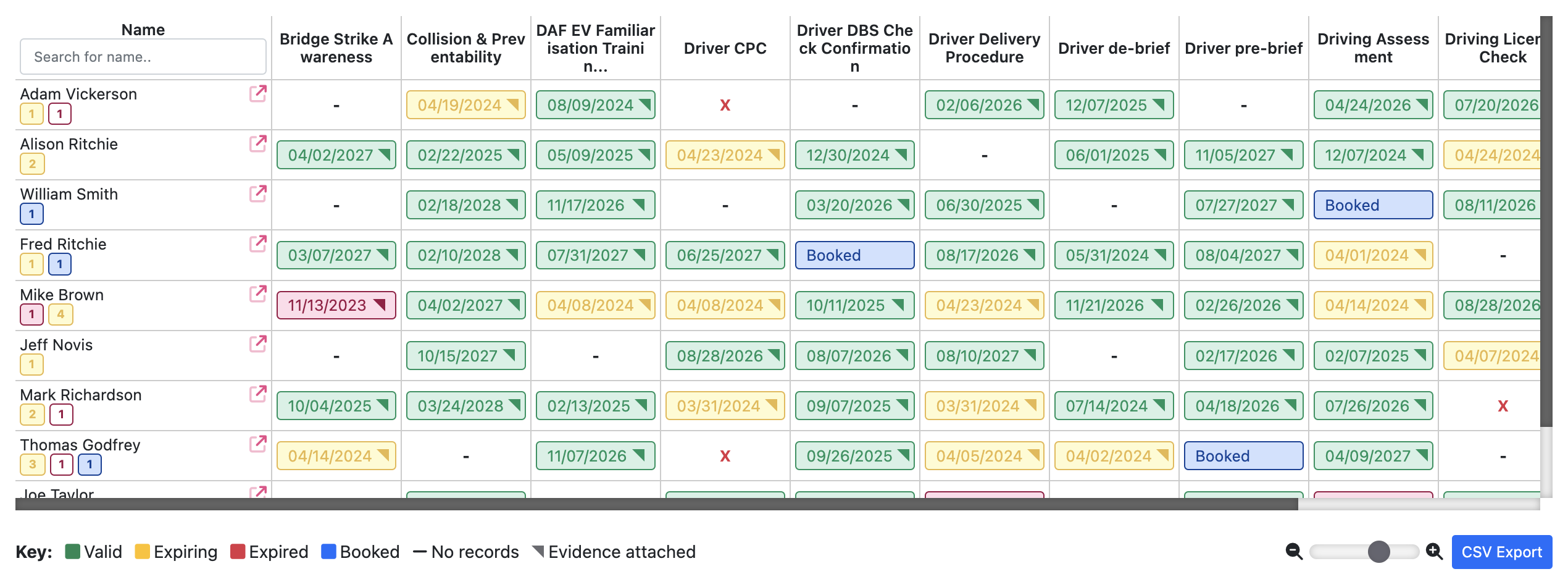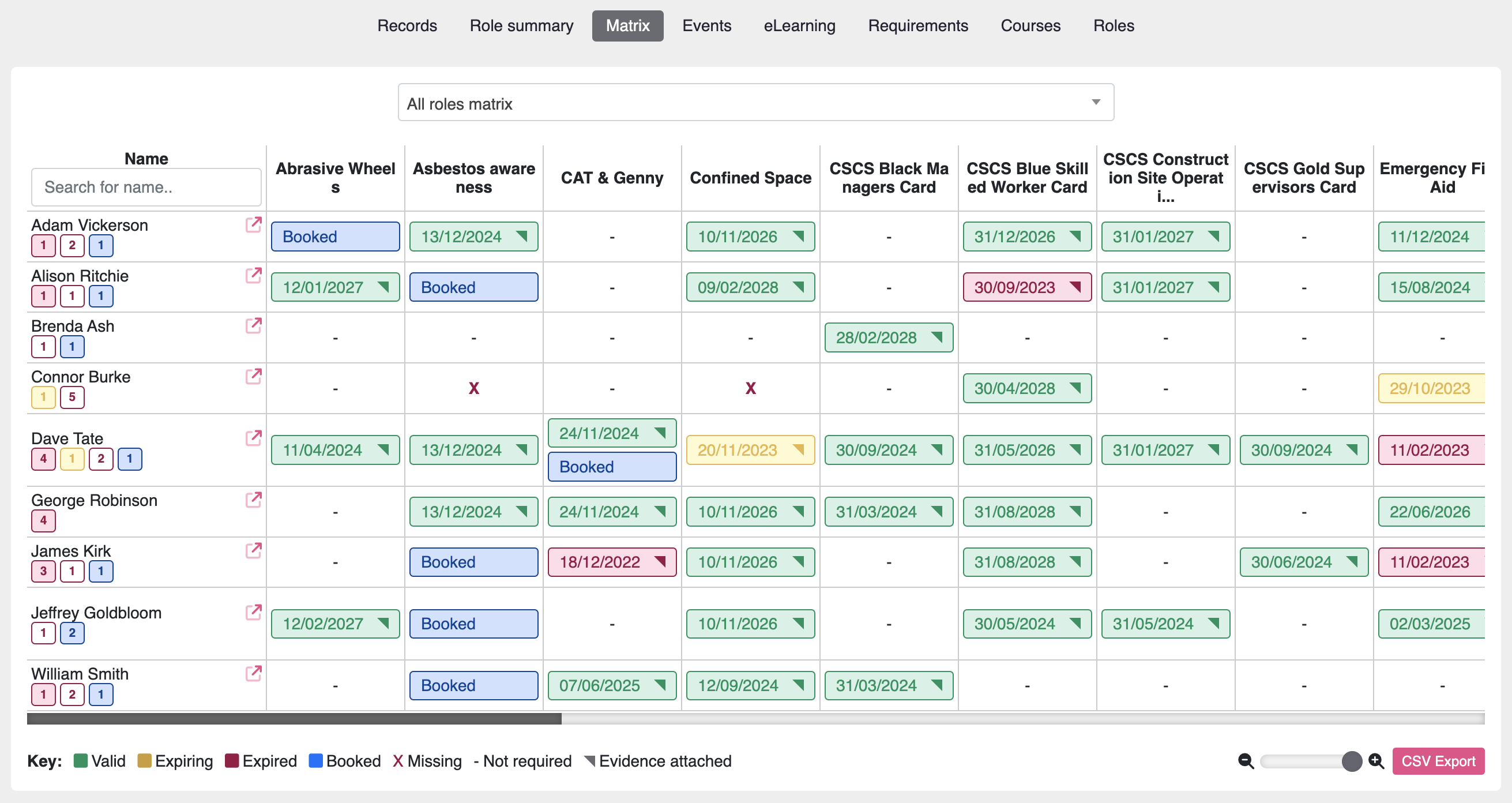As an experienced training coordinator, I’ve seen firsthand the challenges that come with managing employee development along with the benefits of using a training matrix. From tracking who needs which training to ensuring everyone stays compliant with industry standards, the process can quickly become overwhelming. That’s where a training matrix comes in. This tool is a game-changer in providing a clear, organised way to handle all training needs. It’s like having a roadmap for employee growth, and the benefits are numerous. In this article, I’ll share the top ten benefits of using a training matrix and how it can help your organisation thrive.
1. Enhanced Skill Management
First and foremost benefit of using a training matrix is that it provides a comprehensive overview of the skills within an organisation. By visually mapping out employees’ competencies and training needs, managers can easily identify strengths and weaknesses. Consequently, this allows for targeted training efforts, ensuring that resources are allocated efficiently. Furthermore, by addressing skill gaps, organisations can build a highly competent and versatile workforce, which is crucial for maintaining a competitive edge.
2. Improved Employee Engagement and Retention
Employees who see a clear path for their professional development are more likely to be engaged and satisfied with their jobs. Therefore, a training matrix demonstrates an organisation’s commitment to employee growth, providing a roadmap for skill enhancement and career progression. As a result, investing in employees’ development fosters loyalty and reduces turnover rates, ultimately saving on the costs associated with recruiting and training new staff.
3. Streamlined Training Processes
Managing training programmes can be complex, especially in large organisations. However, a training matrix simplifies this process by providing a centralised system for tracking training activities. This ensures that all employees receive the necessary training and that no one is overlooked. Additionally, it helps in coordinating training schedules, avoiding conflicts, and ensuring that resources are used efficiently.
4. Support for Compliance and Certification
In many industries, compliance with regulations and standards is mandatory. A training matrix helps organisations stay compliant by tracking the completion of required training and certifications. This is particularly important in sectors such as healthcare, finance, and manufacturing. Failing to meet regulatory requirements can result in severe penalties. Thus, maintaining an up-to-date training matrix allows organisations to quickly provide evidence of compliance during audits and inspections.
5. Facilitated Performance Reviews
Performance reviews are an integral part of employee development. A training matrix provides valuable data that can be used during these reviews to assess an employee’s progress and identify areas for improvement. It offers a factual basis for discussions about performance, making reviews more objective and constructive. Consequently, this can lead to more personalised development plans and better alignment between employee goals and organisational objectives.
6. Enhanced Organisational Agility
In a rapidly changing business landscape, agility is key to staying ahead. A training matrix enables organisations to quickly adapt to new challenges by identifying and addressing skill gaps. Whether it’s adopting new technologies, entering new markets, or responding to industry trends, having a well-documented training matrix ensures that the workforce is prepared to meet these demands. This agility can be a significant competitive advantage.
7. Promotion of Continuous Improvement
A training matrix encourages a culture of continuous improvement by making training and development a visible and ongoing process. Employees are more likely to pursue further training when they see a clear structure and support for their efforts. This culture not only enhances individual performance but also drives overall organisational growth and innovation. Additionally, it ensures that employees remain current with the latest skills and knowledge, which is vital in today’s fast-paced environment. The best benefits of using a training matrix lead to cultural changes within an organisation.
8. Effective Succession Planning
Succession planning is crucial for the long-term success of any organisation. A training matrix helps identify potential leaders by highlighting employees who have completed relevant training and possess the necessary skills for advancement. This ensures a smooth transition when key positions become vacant, reducing the risk of disruption to operations. Moreover, it allows organisations to develop internal talent, which is often more cost-effective and culturally aligned than external hires.
9. Reduced Training Costs
A benefit of using a training matrix that sometimes gets overlooks is that a well-maintained training matrix can lead to significant cost savings. By identifying and focusing on specific training needs, organisations can avoid redundant or unnecessary training programmes. This targeted approach ensures that resources are spent efficiently, providing maximum return on investment. Additionally, it reduces the time employees spend in training, allowing them to contribute more effectively to their roles.
10. Enhanced Strategic Planning
A training matrix provides valuable insights into the current and future skills landscape of the organisation. This information is crucial for strategic planning, helping leaders make informed decisions about workforce development and resource allocation. By aligning training initiatives with organisational goals, a training matrix ensures that the workforce is equipped to meet future challenges and opportunities.
Conclusion
The benefits of using a training matrix are extensive and far-reaching. From enhancing skill management and improving employee engagement to streamlining training processes and supporting compliance, a training matrix is an invaluable tool for any organisation committed to growth and excellence. By implementing best practices and fostering a culture of continuous improvement, organisations can harness the full potential of their workforce and achieve sustained success.
FAQs – Benefits of Using a Training Matrix
What is a training matrix? A training matrix is a visual tool that outlines the training needs and competencies required for various roles within an organisation. It helps track employee skills, identify gaps, and monitor progress.
How does a training matrix improve skill management? A training matrix provides a clear overview of the skills within an organisation, allowing managers to identify strengths and weaknesses. This enables targeted training efforts and efficient resource allocation.
Can a training matrix help with compliance? Yes, a training matrix helps organisations stay compliant by tracking the completion of required training and certifications. This is crucial in industries with strict regulatory requirements.
What are the best practices for implementing a training matrix? Best practices include tailoring the matrix to your organisation’s needs, keeping it updated, engaging employees, leveraging technology, and continuously monitoring its effectiveness.
How does a training matrix enhance employee engagement? A training matrix shows a commitment to employee development, providing clear pathways for skill enhancement and career progression. This fosters loyalty and reduces turnover rates.
Why is organisational agility important, and how does a training matrix help? Organisational agility is key to adapting to new challenges. A training matrix helps identify and address skill gaps, ensuring the workforce is prepared for changing demands.

Alison is the Moralbox Customer Success Manager. She ensures that our customers enjoy the benefits and get the very best experience out of our products. Alison has over 8 years experience as a training manager.


